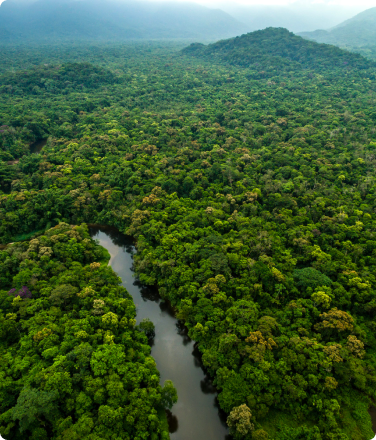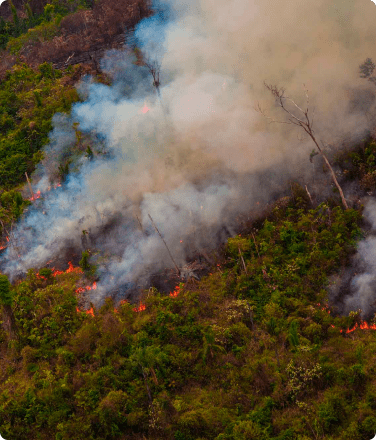- Illegal and unregulated gold mining is fueling the spread of malaria and environmental destruction in Guyana’s South Rupununi region.
- Mercury used for mining poisons entire ecosystems that are essential to biodiversity and the health of Indigenous peoples in the region.
- Rainforest Foundation US (RFUS) is working with the South Rupununi District Council (SRDC) in Guyana to support impacted communities by strengthening monitoring efforts and supporting their advocacy for land rights.
A growing dual crisis of public health and environmental devastation is unfolding in the Amazon rainforest. Over the past decade, a surge in illegal and unregulated gold mining has had the unexpected side effect of leading to a sharp rise in malaria cases, disproportionately affecting Indigenous communities across the Guiana Shield. This vast, ecologically critical region—spanning Guyana, Suriname, French Guiana, and parts of Brazil and Venezuela on the northeastern shoulder of the Amazon basin—now finds itself at the center of this crisis. As mining operations expand, they not only fuel the spread of malaria but also cause severe environmental devastation to the most biodiverse ecosystem on Earth—the Amazon.
The impacts of both illegal and severely underregulated legal gold mining near Marudi Mountain in southwestern Guyana—are far reaching. Here, mining activities are driving environmental destruction and endangering the health, livelihoods, and cultures of Indigenous communities.
Gold Prices Soar, Miners Follow
Marudi Mountain, located in the South Rupununi region of Guyana, is the ancestral home of the Indigenous Wapichan and Wai Wai peoples. Guyana is one of the most densely forested countries in South America, with rainforests covering nearly 87% of its landmass—an area larger than Washington state. Its landscape, a mix of mountains, savannas, and rainforest, forms a rich ecological haven. Home to over 8,000 plant species and 1,800 animal species, Guyana shelters an extraordinary array of wildlife, including iconic Amazonian species such as jaguars and tapirs, among others.
Though the Wapichan have received some land titles for their villages, much of their traditional territory remains unrecognized by the Guyanese government. The Marudi Mountain mining complex lies within this unrecognized land, just outside of the Aishalton and Kraudarenau titled villages. Situated within the Wapichan Headwaters, the mountain is home to the sources of several of Guyana’s major rivers, including the Rupununi, Rewa, and key tributaries of the Essequibo. The Essequibo is the country’s main waterway, providing the capital city of Georgetown’s primary water supply, while the surrounding rivers and creeks are essential for sustaining local communities and vital aquatic ecosystems. Gold mining—both legal and illegal—has long been practiced in the region, but due to weak regulation, many operations remain unchecked. Over the past decade, soaring gold prices have driven an increase in mining activity throughout the world, including at Marudi Mountain. Spatial data and on-the-ground observations confirm the rapid expansion of mining camps near Marudi Mountain, more than doubling from 20 to 50 camps in just the past year alone. As these camps spread, they bring a slew of environmental and public health issues to Indigenous communities.
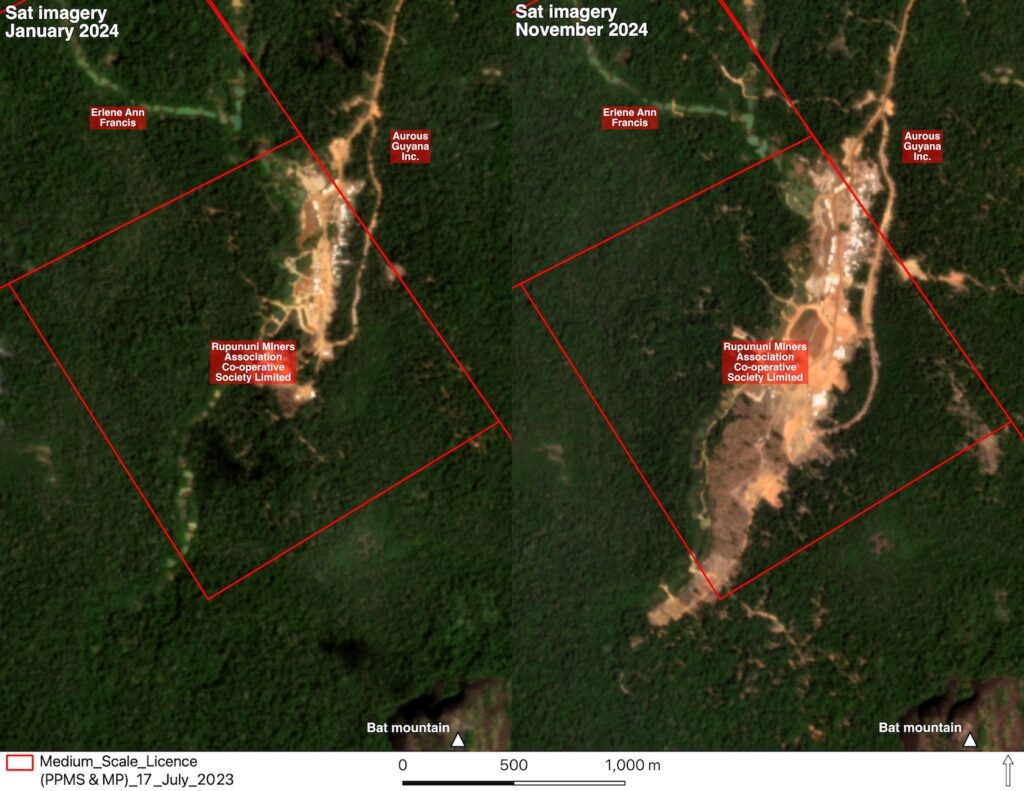
Mining activity at the Rupununi Miners Association license more than doubled between January and November 2024. By the end of the year, mining activity was spilling outside of the approved claim boundary.
Malaria Cases Escalate
“In Guyana, the international gold price is the single best predictor of malaria cases.” – Pablo M. De Salazar, et al., (2024), The Lancet Regional Health – Americas.
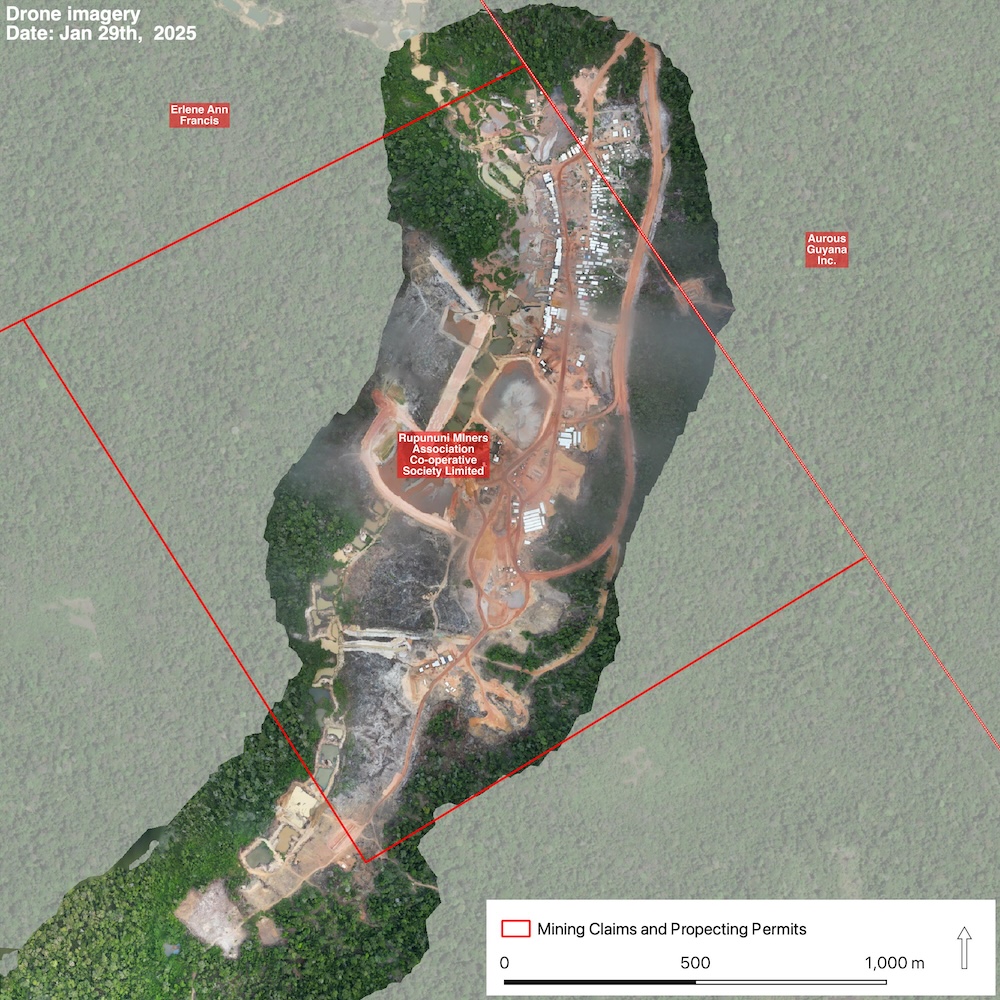
Malaria is a life-threatening mosquito-borne disease that can be fatal without timely treatment and access to healthcare. In the Amazon, gold mining disrupts natural river flows by blocking channels and altering drainage, creating stagnant water pools. Additionally, deforestation from mining clears forest patches, both of which create ideal ecological breeding grounds for malaria-carrying mosquitoes. For the Indigenous communities located in these remote areas, accessing healthcare is often extremely difficult—and in some cases, impossible—leaving them particularly vulnerable to disease.
The surge in mining at Marudi Mountain has been further intensified by an influx of miners from Brazil. In 2023, the Brazilian government declared a public health emergency and launched a large-scale operation to expel thousands of illegal miners from Yanomami lands near the border with Guyana. Illegal gold mining there had devastated forests and waterways, leaving entire communities grappling with malaria and severe malnutrition. According to official health services, in 2023 alone, malaria cases among the Yanomami rose by 61%, with over 25,000 infections reported and 535 deaths among children under five. The remote nature of Yanomami territory made medical access incredibly challenging. While Brazil’s efforts removed miners from Yanomami lands, research shows that this action also sparked a mass migration of displaced miners across the border into Guyana1.
Today, malaria outbreaks are well-documented across Guyana, with 75% of cases directly linked to mining2. Malaria is also currently one of the three most prevalent health challenges affecting Indigenous children across the country3.
Cultural Impacts Deepen
Beyond health impacts, mining at Marudi Mountain brings a host of social challenges. Reports of prostitution, gender-based violence, and other issues accompany the destruction of cultural and spiritual sites of deep significance to the Wapichan peoples. The erosion of profound cultural heritage—such as the transmission of stories, traditional knowledge, and language—is a growing concern, as the Wapichan youth are being drawn away from communities to work at the mines.
“As mothers we are the ones who must face these issues with our children. Our young boys are running to Marudi and abusing drugs ….We are only thinking of the money and the gold, but our young men are being abused,” said a community member at a recent meeting on the impacts of mining at Marudi Mountain.
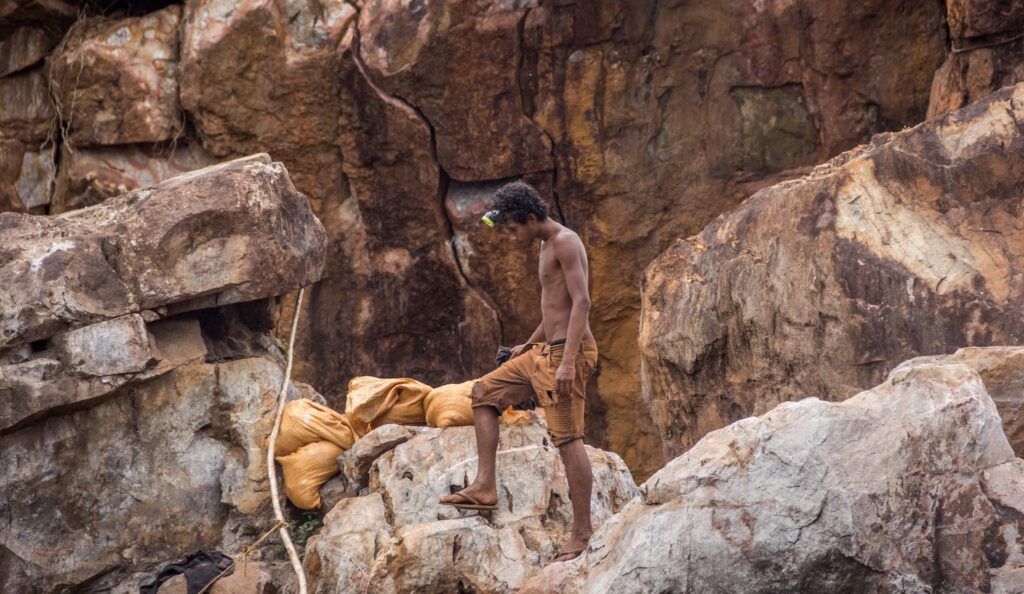
Ecosystem Destruction
While mining contributes less to deforestation than activities like cattle ranching, its impacts are uniquely harmful. Mercury, used to extract and purify gold, poisons entire ecosystems by contaminating soil and rivers, depriving communities of access to clean water for drinking and bathing. This pollution also poses a grave threat to aquatic life, particularly fish—a crucial dietary staple for Wapichan communities. A study by Guyana’s Ministry of Public Health found that Parabara Village, located next to Marudi Mountain, recorded the highest levels of mercury contamination among Indigenous communities in the region4. And research from the World Health Organization (WHO) further underscores the risks, showing that women and children are particularly vulnerable. In pregnant women, mercury crosses the placenta, exposing developing fetuses to concentrations up to seven times higher than in other individuals, causing irreversible harm. Yet, miners at Marudi Mountain continue to use mercury, despite the government’s pledge to eliminate it by 2025 under the Minamata Convention.
Our health, our land, our water is life. And today it is all polluted….I am a mother for my community and for my youth, and I know they are at risk. Our youth go to Marudi and they come back with malaria.
Safeguarding Indigenous Peoples’ Lands
To support Wapichan communities impacted by the influx of miners, the SRDC and RFUS are partnering with the New York University Global Justice Clinic, Forest Peoples Programme, and Harvard University. This collaboration provides training for SRDC water monitors, data managers, and cultural heritage team members in the use of advanced surveillance tools, including mercury testing equipment capable of detecting contamination in soil, fish, and humans. These efforts aim to enhance monitoring, improve data collection, and equip communities with the tools necessary to address the environmental and health impacts of mining on their lands. As health concerns for Indigenous communities continue to grow, these initiatives are crucial for safeguarding both the environment and the health of the Wapichan peoples.
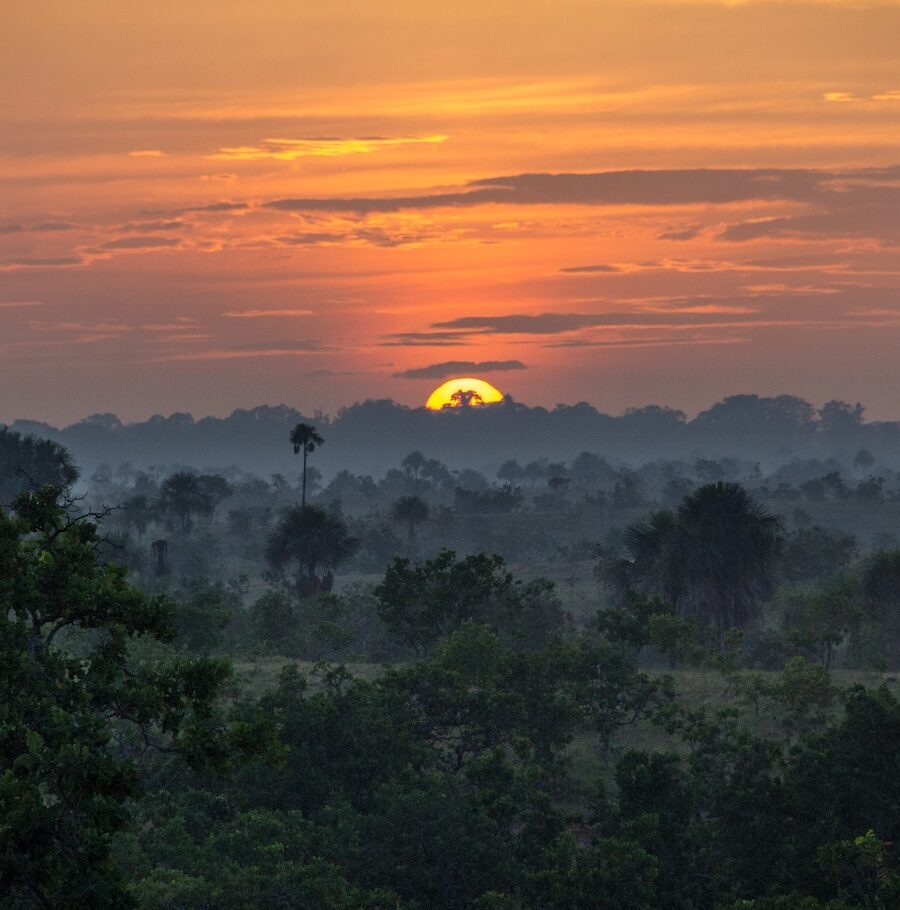
While strengthening local monitoring is essential, the long-term protection of Wapichan lands depends on securing and extending land titles for Indigenous communities. Without formal recognition, they face ongoing challenges in defending their territories from external threats. Securing land tenure is paramount to protecting rivers, forests, and people from the devastating impacts of mining. To advance this goal, RFUS is working with SRDC to develop a comprehensive management strategy for their headwaters. The Wapichan Headwaters Management Plan lays out a framework for securing full recognition of Wapichan land rights, safeguarding natural and cultural heritage in the region, and ensuring that Indigenous communities can collectively address mining and other destructive activities on their lands.
The impacts of mining at Marudi are severe and range from environmental damage and social disruption to malaria and mercury toxicity in local populations. However, they are symptoms of lack of land security for Indigenous people in Guyana. When local communities have legal ownership over the lands they have cared for over generations, they make good decisions about its future.
Learn more about Indigenous-led rainforest protection and keep up with the latest developments in our work by signing up for our email list today.
Sources:
- De Salazar, P. M., Parra-Salazar, A., Niles-Robin, R., Valz, O., James, K., Buckee, C. O., & Cox, H. (2025). Malaria spillover in Indigenous Guyanese communities following a crackdown on illegal gold mining in Brazil. The Lancet Regional Health–Americas, 42. ↩︎
- De Salazar, P. M., Parra-Salazar, A., Niles-Robin, R., Valz, O., James, K., Buckee, C. O., & Cox, H. (2025). Malaria spillover in Indigenous Guyanese communities following a crackdown on illegal gold mining in Brazil. The Lancet Regional Health–Americas, 42. ↩︎
- UNICEF, “Study on Indigenous Women & Children in Guyana”, 2017. ↩︎
- Watson, L. C., Hurtado-Gonzales, J. L., Chin, C. J., & Persaud, J. (2020). Survey of methylmercury exposures and risk factors among indigenous communities in Guyana, South America. Journal of Health and Pollution, 10(26). ↩︎


